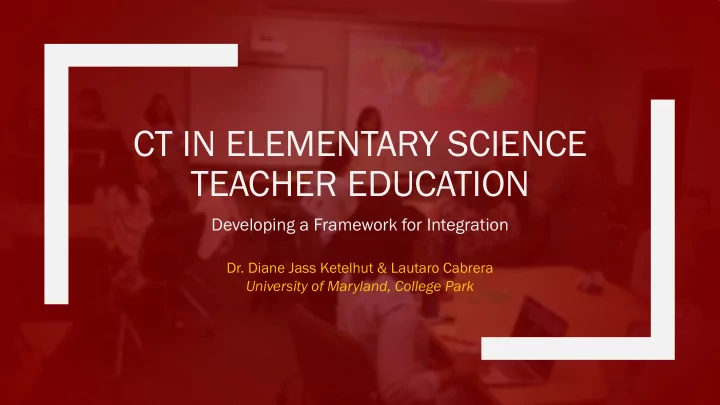

CT IN ELEMENTARY SCIENCE TEACHER EDUCATION Developing a Framework for Integration Dr. Diane Jass Ketelhut & Lautaro Cabrera University of Maryland, College Park
Our Project ■ CT Integrated into Elementary Science Methods Course – Focused on four sessions – Final assignment: CT-infused science lesson – Modest results: preservice teachers used CT terms loosely ■ Professional Development experience – Science Teaching Inquiry Group in Computational Thinking (S (STI TIG CT CT ) – Pre-service and in-service teachers learn and work together, including mentor-mentees pairs – Researchers and teachers co-design CT-infused science lesson plans – Introduce teachers to CT concepts through elementary school science activities
Framework Development ■ For both the course and the STIG CT , we iteratively developed a framework for integrating CT into elementary science. ■ The framework guided participant learning, discussion around CT, and integration of CT into lesson plans. ■ Different versions of the framework were accompanied by different results in how teachers integrated CT
FRAMEWORK YEAR 1
Our Framework Iterations: Year 1 ■ Drew from multiple sources: – Weintrop et al. (2016): CT practices specifically for science and math – CSTA & ISTE (2011): inclusion of dispositions and attitudes – Barr & Stephenson (2011): use of concrete examples ■ Created our own examples of each CT Practice (from Weintrop et al.)
Weintrop et al. (2016) CSTA & ISTE (2011) Data Practices Collecting Data Creating Data Manipulating Data Analyzing Data Visualizing Data Modeling & Simulation Practices Using Computational Models to Understand a Concept Using Computational Models to Find and Test Solutions Assessing Computational Models Designing Computational Models Constructing Computational Models Computational Problem-Solving Practices Preparing Problems for Computational Solutions Programming Choosing Effective Computational Tools Assessing Different Approaches/Solutions to a Problem Developing Modular Computational Solutions Creating Computational Abstractions Troubleshooting and Debugging Systems Thinking Practices Investigating a Complex System as a Whole Understanding the Relationships within a System Thinking in Levels
Year 1 “Framework” Challenges ■ The framework language was sometimes inaccessible or overwhelming for teachers—it was based on CS terminology – E.g., algorithmic thinking or computational abstraction ■ Hard to differentiate CT practices from other more common scientific practices – E.g., CT data collection vs. science data collection
FRAMEWORK YEAR 2
Using Data Programming Systems Thinking from a Computational Simulations CT Perspective
Unified sources into one framework
Reduced number of practices
Simplified language to avoid CS jargon Formerly “Algorithmic Thinking”
Differentiated CT from science practices Added a quantifiable or numerical component
Preliminary Results ■ With the new framework, teachers are feeling more comfortable integrating CT – Both in written reflections and self-efficacy measures ■ They are more successfully integrating CT into their lesson plans than in Year 1 – The instances of CT in their lesson plans more closely resembled the CT practices of the framework ■ Mentors and mentees are benefitting from working together – Different but complementary expertise
Remaining Challenges ■ Almost no teachers integrated Systems Thinking from a CT Perspective. Are these practices appropriate for the elementary level? ■ Simplifying language to avoid CS jargon may have led to some superficial uptake – Sometimes “step-by-step instructions” meant following any type of procedure was considered CT
Moving Forward ■ How are teachers implementing the lessons they design? – What are the instances of CT that are developmentally appropriate, work within school structures, and teachers feel comfortable integrating? ■ Which CT practices are making it into the Elementary classroom? – How is the framework guiding the design and implementation of lessons?
QUESTIONS? THANK YOU! Dr. Diane Jass Ketelhut & Lautaro Cabrera Randy McGinnis, Jan Plane, Kelly Mills, Merijke Coenraad and Heather Killen University of Maryland, College Park djk@umd.edu | cabrera1@umd.edu This material is based upon work supported by the National Science Foundation under Grant No. 1639891. Any opinions, findings, and conclusions or recommendations expressed in this material are those of the author(s) and do not necessarily reflect the views of the National Science Foundation.
Recommend
More recommend